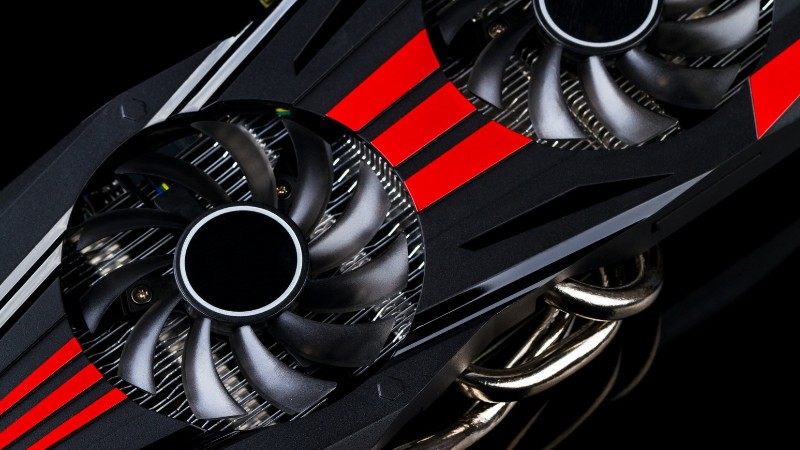
Expert Consulted: Adrian Gardiner. Years of experience buying both computers and computer parts for my own new customer builds has given me a unique perspective on building PCs. In this article, I’ll be sharing my knowledge with you to answer the question: What does Ti mean in graphics cards?
Since 2001, NVIDIA has been using the letters Ti on some of their high-end graphics cards, like the 4070 Ti, for example. But what do these letters mean?
Ti stands for Titanium and means a more powerful version of a standard Nvidia GPU. Ti cards have increased specs like more CUDA cores and faster memory compared to non-Ti models. Ti sits between standard and Titan RTX GPUs in Nvidia’s lineup, with better performance at a higher price for enthusiasts.
The rest of my article goes into more detail on these more powerful Ti graphics cards and whether you should consider fitting one to your own gaming PC.
This post contains affiliate links; click here to read our affiliate policy.
What Does Ti Mean In Graphics Cards? Explained.
The ‘Ti’ designation is simply a branding term used by NVIDIA and stands for “Titanium”. NVIDIA uses the Ti lettering to show that the GPU is a more powerful version of the non-Ti model with the same product number.
For example, the Nvidia RTX 4070 Ti is the more powerful version of the RTX 4070, but not as powerful as the RTX 4080. The ‘Ti’ label just differentiates between different versions of the same model number.
Note that the ‘Ti’ label doesn’t mean that the GPU actually contains any Titanium – it’s simply a fancy naming convention used by NVIDIA to show that the card is a more powerful version of the non-Ti model.
The Ti version of an NVIDIA graphics card is usually released sometime after the standard version of the same card and is a way of easily providing a higher-performance version of an already released card, often to counter similar competing products from AMD.
AMD also has its own special lettering for its high-performance versions of various graphics cards like the AMD RX 6800 and RX 6800 XT.
Performance Difference Between Ti and Non-Ti GPUs
Here’s a quick comparison table for currently available NVIDIA Ti and non-Ti graphics card models that show the specification differences.
| GPU | CUDA Cores | VRAM | Base Clock Speed | GPU Benchmarks Rating (lower is better) | |
| 1. | RTX 3060 | 3584 | 8 / 12 GB GDDR6 128 / 192 Bit | 1.32 GHz | 56 |
| 2. | RTX 3060 Ti | 4864 | 8 GB GDDR6X 256 Bit | 1.41 GHz | 31 |
| 3. | RTX 3080 | 8704/ 8960 | 10 / 12 GDDR6X 320 / 384 Bit | 1.44 / 1.26 GHz | 13 |
| 4. | RTX 3080 Ti | 10240 | 12 GDDR6X 384 Bit | 1.37 GHz | 9 |
| 5. | RTX 3090 | 10496 | 24 GDDR6X 384 Bit | 1.4 GHz | 8 |
| 6. | RTX 3090 Ti | 10752 | 24 GDDR6X 384 Bit | 1.56 GHz | 5 |
| 7. | RTX 4060 | 3072 | 8 GB GDDR6 128 Bit | 1.83 GHz | 38 |
| 8. | RTX 4060 Ti | 4352 | 8 GB GDDR6 128 Bit | 2.31 GHz | 23 |
| 9. | RTX 4070 | 5888 | 12 GB GDDR6X 192 Bit | 1.83 GHz | 12 |
| 10. | RTX 4070 Ti | 7680 | 12 GB GDDR6X 192 Bit | 2.31 GHz | 4 |
From the above table listings, you can see a clear difference in the performance rating between the non-Ti and Ti models, a direction reflection of the enhanced specification built into the Ti cards.
Should You Upgrade to a ‘Ti’ Graphics Card?
Whether you should spend the extra money on a Ti variant will depend on your budget and gaming needs, especially as the Ti models are always more expensive than their non-Ti versions.
If you want the best performance you can get and have the budget, then yes, I’d purchase the Ti.
However, for each of the NVIDIA cards listed, the non-Ti GPU is still going to be an excellent gaming choice.
Check Your PC for Compatibility
Also, check your PC to ensure that a) the card will fit into your computer case as a more powerful card usually means increased size, and b) that your power supply unit (PSU) has a high enough rating to cope with the additional power demand (the GPU manufacturer will usually state the minimum PSU size).
Cost Implications of Ti GPUs
There will always be a cost implication with a Ti graphics card, so you’ll need to consider whether the extra expense is worth the additional performance or whether a standard non-Ti GPU will suffice.
For example, the MSI Gaming GeForce RTX 4070 currently retails for £599.99 on Amazon. The Ti variant of this card currently retails for around $900.00, so a huge increase in cost for roughly a 30% increase in performance for this particular model.
Ti Graphics Card Buying Considerations

When looking for a new graphics card and, in particular, a more powerful Ti version, I recommend checking the following:
Memory
More and more games are demanding ever higher amounts of VRAM (as high as 12 GB!) to run games smoothly at high or ultra settings, so more is good if your chosen card offers it.
If you have a smaller monitor or don’t plan to run your games at 4K or ultra-high settings, then you’ll be able to get away with less VRAM (i.e., 6 or 8 GB).
8 GB of VRAM is fast becoming the current minimum for today’s games at low to medium game settings, but many will now need at least 12 GB or more to play hard at 4K.
If you want to really push the envelope and run your games at high resolutions like 1080p or 4K and max out the game settings, here are a few examples of games that are likely to need a minimum of 12 GB of VRAM:
- Forspoken
- Hogwarts Legacy
- The Callisto Protocol
- Resident Evil 4
- Dead Space Remake.
Note that these games will run with lower VRAM but not at high or ultra game settings.
So, to summarise, 6 GB would be the minimum amount of VRAM, 8 GB is ideal, and anything over 12 GB would be excellent and will give you good future-proofing.
However, it’s worth noting that Ti versions of NVIDIA graphics cards usually have the same amount of VRAM as standard cards.
Performance
Check the number of cores and, in particular, the clock speeds available (both standard and boosted) – these numbers will be higher with Ti models and are where the extra performance will come from. The more cores and the higher the clock frequency, the better.
System Compatibility
Will the card you’ve chosen actually fit inside your computer case? The more powerful the card, usually the bigger it will be, both in terms of its length and how many slot spaces it will take.
The RTX 4070 Ti, for example, will measure around 9.6″ long and take between 2-3 slots, depending on the manufacturer – it’s a big card!
PSU Rating and GPU Power Consumption
Does your current PSU measure up to the required extra power load on your system? Bigger cards consume more power, meaning you might have to upgrade. Graphics card manufacturers will usually specify the minimum recommended power supply rating – for the RTX 4070 Ti, this would be 700w.
Brand and Reputation
To ensure good reliability, support, and long usable life, try to buy from a reputable and well-known brand. Brands I’ve worked with and can recommend would include AsRock, ASUS, Gigabyte, EVGA, and MSI.
Price
The price range for Ti cards is huge so your budget will likely weigh heavily on your purchasing decision.
It’s not always necessary to buy the latest and greatest card to get an excellent gaming experience, so choose according to your pocket after making sure the GPU you select will play your games to an acceptable level.
The second-hand market for these powerful cards is usually very strong, meaning if the card has been looked after, it can easily be sold later and put towards an upgrade when the time is right.
Frequently Asked Questions

Here is a selection of questions with answers that are commonly asked in relation to the Ti GPU variants.
Q1 Can ‘Ti’ graphics cards fit into any computer setup?
Not in any computer, no; you would first need to check the available free space in your PC case as more powerful graphics cards like Ti variants are often much larger, particularly in length.
Also, you need to check to ensure that the fitted power supply unit (PSU) is rated high enough to cope with the additional power requirements of the GPU.
Q2 Do ‘Ti’ graphics cards always consume more power than their non-Ti versions?
Yes, usually, Ti cards do consume more power than their standard counterparts, meaning a more powerful PSU may be required. For example, the RTX 4070 requires a 650w minimum PSU, and the RTX 4070 Ti is a more powerful PSU rated for a minimum of 700w.
Q3 Are ‘Ti’ versions always more expensive?
As a result of the enhanced specification found with Ti models, the prices are always higher than their lesser non-Ti models.
Final Words
So, the Ti version of an NVIDIA graphics card represents the higher performance variant of a particular card, at an extra expense, of course. To be able to deliver this higher performance, the Ti cards come with more CUDA cores and higher clock speeds than their standard counterparts.
Be careful to make sure that any new Ti card will fit in your computer case and that the PSU is man enough for the job, as these cards usually consume more power.
The Ti badge is always going to mean higher performance, making it a quick and easy way to differentiate between different cards. Whether you should buy one would depend on your budget and particular needs.
Image Attribution and Licensing
#1: ‘Graphic Card’ by Alexxl (Canva)
#2: ‘Frequently Asked Questions’ by ileezhun (Getty Images / Canva)

